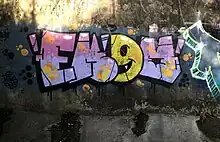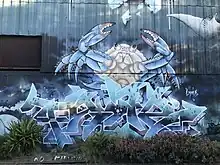
Pieces, short for masterpieces, are a form of graffiti that involves large, elaborate and detailed letter forms. They are one of the main forms of modern graffiti, along with tags and throw ups, and are the least controversial of the three[1] and least likely to be seen as vandalism.
Due to their size, pieces are almost always done in aerosol spray paint, but may use paint rollers for large fill-ins.[1]
Form
Pieces tend to be large, with multi-coloured fills and outlines. They often incorporate highlights, shadows, and a background,[2] and may use extensions, 3D effects,[2] and sometimes characters.[3]
Because of their complexity and large size, pieces usually take a significant amount of time to plan and paint[4] and therefore are often found on legal walls.[5] Illegal pieces tend to be found in less crowded spaces such as train yards, tunnels, drains, rooftops, and walls facing train tracks.[4] Illegal pieces done in busier areas are often done over multiple nights[6] or by multiple members of a crew.[7]

Many people unfamiliar with graffiti forms can find it difficult to distinguish the letters in more elaborate pieces.[2] While straight-letters are pieces with clear letters that prioritise legibility, wildstyle pieces have extremely exaggerated letters forms with multiple extensions and add-ons, and are often illegible to many people. This may be a deliberate choice to allow only those familiar with the art form to read them.[8] Some writers choose to sign their pieces with personal and crew tags.[7]
History
Pieces were first observed in the 1980s on trains in the New York Subway, until the metro began refusing to put out painted trains in an attempt to discourage writers, which had the unintended effect of writers instead painting pieces on city walls.[9]
Pieces are more likely to be considered a "true" art form by people outside of the graffiti community. With the rise of commercial graffiti since the late 2000s, legal pieces are sometimes commissioned by local businesses as promotion[6] or by local councils with the intention of discouraging less appreciated forms of graffiti such as tags, given that many writers will not go over another artist's work.[10][11]
References
- 1 2 Snyder, Gregory J. (2011-04-15). Graffiti Lives: Beyond the Tag in New York's Urban Underground. NYU Press. ISBN 978-0-8147-4046-0.
- 1 2 3 Gottlieb, Lisa (2014-01-10). Graffiti Art Styles: A Classification System and Theoretical Analysis. McFarland. ISBN 978-0-7864-5225-5.
- ↑ Mansfield, Michelle (2021-09-23), "Collective Individualism: Practices of Youth Collectivity within a Graffiti Community in Yogyakarta, Indonesia", Forms of Collective Engagement in Youth Transitions, Brill, pp. 115–138, ISBN 978-90-04-46634-0, retrieved 2023-08-28
- 1 2 Docuyanan, Faye (2000). "Governing Graffiti in Contested Urban Spaces". PoLAR: Political and Legal Anthropology Review. 23: 103–121. doi:10.1525/pol.2000.23.1.103.
- ↑ Snyder, Gregory (2016). "Long Live the Tag: Representing the Foundations of Graffiti". In Tsilimpoinidi, M; Avramidis, K (eds.). Graffiti and Street Art: Reading, Writing and Representing the City. Taylor & Francis. ISBN 9781317125051.
- 1 2 Ross, Jeffrey Ian (2016-03-02). Routledge Handbook of Graffiti and Street Art. Routledge. ISBN 978-1-317-64586-3.
- 1 2 Ferrell, Jeff (1996), "Freight Train Graffiti: Subculture, Media, Dislocation", Making Trouble, Routledge, doi:10.4324/9780203786628-15, ISBN 978-0-203-78662-8, retrieved 2023-08-29
- ↑ Gopinath, Gabrielle (2015), "Ornament as Armament: Playing Defense in Wildstyle Graffiti", Understanding Graffiti, Routledge, doi:10.4324/9781315416137-11, ISBN 978-1-315-41613-7, retrieved 2023-08-28
- ↑ Snyder, Gregory J. (2006-04-01). "Graffiti media and the perpetuation of an illegal subculture". Crime, Media, Culture. 2 (1): 93–101. doi:10.1177/1741659006061716. ISSN 1741-6590. S2CID 144911784.
- ↑ Dovey, Kim; Wollan, Simon; Woodcock, Ian (2012-02-02). "Placing Graffiti: Creating and Contesting Character in Inner-city Melbourne". Journal of Urban Design. 17 (1): 21–41. doi:10.1080/13574809.2011.646248. hdl:11343/230654. ISSN 1357-4809. S2CID 110689365 – via Taylor & Francis Online.
- ↑ "Why Don't Murals Get Covered By Graffiti in the Mission?". KQED. 2015-05-19. Retrieved 2023-09-04.